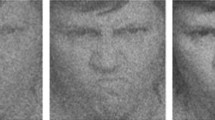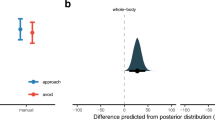Abstract
Facial expressions of anger and fear have been seen to elicit avoidance behavior in the perceiver due to their negative valence. However, recent research uncovered discrepancies regarding these immediate motivational implications of fear and anger, suggesting that not all negative emotions trigger avoidance to a comparable extent. To clarify those discrepancies, we considered recent theoretical and methodological advances, and investigated the role of social preferences and processing focus on approach-avoidance tendencies (AAT) to negative facial expressions. We exposed participants to dynamic facial expressions of anger, disgust, fear, or sadness, while they processed either the emotional expression or the gender of the faces. AATs were assessed by reaction times of lever movements, and by posture changes via head-tracking. We found that—relative to angry faces-, fearful and sad faces triggered more approach, with a larger difference between fear and anger in prosocial compared to individualistic participants. Interestingly, these findings are in line with a recently developed concern hypothesis, suggesting that—relative to other negative expressions—expressions of distress may facilitate approach, especially in participants with prosocial preferences.






Similar content being viewed by others
Notes
The concept of SVO refers to preferences for particular patterns of outcomes for the self and others by focusing on a category typology of prosocials (maximizing outcomes for the self and others) vs. individualism (maximizing outcomes for the self with little or no regard for others’ outcomes). It is therefore theoretically manifest to separate participants into separate groups based on their tendency to maximize joint outcome (prosocial) vs. own outcome (individualist) (see Murphy et al. 2011). Individual subjects’ scores can be diminished to the categorical level following this scheme: Altruism: SVO > 57.15. Prosociality: 22.45 < SVO < 57.15. Individualism: −12.04 < SVO < 22.45. Competitiveness: SVO < −12.04.
Yet, in the HT procedure too, emotion affected AATs only in the emotional processing condition. No significant effects of emotion could be found when analyzing the data from the non-emotional condition only.
Separate LMMs on the data of the lever procedure reveal a significant effect of processing condition for each of the 4 emotions.
However, given this explanation, one would also expect a significant interaction of processing focus and emotion in the HT procedure, because participants in the emotional processing condition were asked to count the occurrence of 2 categories (emotions) but only one category (e.g., “male”) was relevant in the non-emotional processing condition.
References
Baayen, R. H., Davidson, D. J., & Bates, D. M. (2008). Mixed-effects modeling with crossed random effects for subjects and items. Journal of Memory and Language, 59(4), 390–412.
Bagozzi, R. P., & Moore, D. J. (1994). Public service advertisements: Emotions and empathy guide prosocial behavior. Journal of Marketing, 58(1), 56–70.
Balliet, D., Parks, C., & Joireman, J. (2009). Social value orientation and cooperation in social dilemmas: A meta-analysis. Group Processes & Intergroup Relations, 12(4), 533–547. doi:10.1177/1368430209105040.
Bogaert, S., Boone, C., & Declerck, C. (2008). Social value orientation and cooperation in social dilemmas: A review and conceptual model. British Journal of Social Psychology, 47(3), 453–480. doi:10.1348/014466607X244970.
Bossuyt, E., Moors, A., & De Houwer, J. (2014). On angry approach and fearful avoidance: The goal-dependent nature of emotional approach and avoidance tendencies. Journal of Experimental Social Psychology, 50, 118–124. https://doi.org/10.1016/j.jesp.2013.09.009.
Bradley, M. M., Codispoti, M., Cuthbert, B. N., & Lang, P. J. (2001). Emotion and motivation I: Defensive and appetitive reactions in picture processing. Emotion, 1, 276–298.
Bradley, M. M., Cuthbert, B. N., & Lang, P. J. (1990). Startle reflex modification: Emotion or attention? Psychophysiology, 27(5), 513–522.
Brindza, J., Sweda, J., Liao, Q., Jiang, Y., & Striegel, A. (2009). WiiLab: Bringing together the Nintendo Wiimote and MATLAB. Paper presented at the Proceedings of the 39th IEEE international conference on Frontiers in education conference, San Antonio, TX, USA.
Cacioppo, J. T., Priester, J. R., & Bernston, G. G. (1993). Rudimentary determinants of attitudes. II: Arm flexion and extension have differential effects on attitudes. Journal of Personality and Social Psychology, 65(1), 5–17.
Chen, M., & Bargh, J. (1999). Consequences of automatic evaluation: Immediate behavioral predispositions to approach or avoid the stimulus. Personality and Social Psychology Bulletin, 25(2), 215–224. doi:10.1177/0146167299025002007.
Darwin, C. (1965). The expression of the emotions in man and animals. Chicago: University of Chicago Press.
Eder, A., Elliot, A., & Harmon-Jones, E. (2013). Approach and avoidance motivation: Issues and advances. Emotion Review, 5(3), 227–229. doi:10.1177/1754073913477990.
Eder, A. B., & Rothermund, K. (2008). When do motor behaviors (mis)match affective stimuli? An evaluative coding view of approach and avoidance reactions. Journal of Experimental Psychology, 137(2), 262–281.
Eerland, A., Guadalupe, T., Franken, I., & Zwaan, R. (2012). Posture as index for approach-avoidance behavior. Plos ONE, 7(2), e31291. doi:10.1371/journal.pone.0031291.
Eisenberg, N., Fabes, R. A., Miller, P. A., Fultz, J., Shell, R., Mathy, R. M., & Reno, R. R. (1989). Relation of sympathy and personal distress to prosocial behavior: A multimethod study. Journal of Personality and Social Psychology, 57(1), 55–66.
Eisenberg, N., & Miller, P. (1987). The relation of empathy to prosocial and related behaviors. Psychological Bulletin, 101(1), 91–119. doi:10.1037//0033-2909.101.1.91.
Ekman, P. (1971). Universals and cultural differences in facial expression of emotion. In J. Cole (Ed.), Nebraska symposium on motivation, Vol 19 (pp. 207–283). Lincoln: University of Nebraska Press.
Ekman, P., & Friesen, W. (1971). Constants across cultures in the face and emotion. Journal of Personality and Social Psychology, 17(2), 124–129. doi:10.1037/h0030377.
Elliot, A. (2006). The hierarchical model of approach-avoidance motivation. Motivation and Emotion, 30(2), 111–116. doi:10.1007/s11031-006-9028-7.
Elliot, A. J., & Covington, M. V. (2001). Approach and avoidance motivation. Educational Psychology Review, 13(2), 73–92.
Grillon, C., & Charney, D. R. (2011). In the face of fear: Anxiety sensitizes defensive responses to fearful faces. Psychophysiology, 48(12), 1745–1752. http://doi.org/10.1111/j.1469-8986.2011.01268.x.
Harmer, C. J., Mackay, C. E., Reid, C. B., Cowen, P. J., & Goodwin, G. M. (2006). Antidepressant drug treatment modifies the neural processing of nonconscious threat cues. Biological Psychiatry, 59(9), 816–820.
Harmon-Jones, E. (2003). Anger and the behavioral approach system. Personality and Individual Differences, 35(5), 995–1005.
Harmon-Jones, E., & Peterson, C. K. (2008). Effect of trait and state approach motivation on aggressive inclinations. Journal of Research in Personality, 42, 1381–1385.
Horstmann, G. (2003). What do facial expressions convey: Feeling states, behavioral intentions, or actions requests? Emotion, 3(2), 150–166. doi:10.1037/1528-3542.3.2.150.
Kaltwasser, L., Hildebrandt, A., Wilhelm, O., and Sommer, W. (2017). On the relationship of emotional abilities and prosocial behavior. Evolution and Human Behavior, 38, 298–308. https://doi.org/10.1016/j.evolhumbehav.2016.10.011.
Krieglmeyer, R., & Deutsch, R. (2010). Comparing measures of approach-avoidance behaviour: The manikin task vs. two versions of the joystick task. Cognition and Emotion, 24(5), 810–828. doi:10.1080/02699930903047298.
Krieglmeyer, R., Deutsch, R., De Houwer, J., & De Raedt, R. (2010). Being moved: Valence activates approach-avoidance behavior independently of evaluation and approach-avoidance intentions. Psychological Science, 21(4), 607–613. doi:10.1177/0956797610365131.
Lang, P., Bradley, M., & Cuthbert, B. (1990). Emotion, attention, and the startle reflex. Psychological Review, 97(3), 377–395. doi:10.1037/0033-295x.97.3.377.
Lavender, T., & Hommel, B. (2007). Affect and action: Towards an event-coding account. Cognition and Emotion, 21(6), 1270–1296. doi:10.1080/02699930701438152.
Marsh, A., Ambady, N., & Kleck, R. (2005). The effects of fear and anger facial expressions on approach- and avoidance-related behaviors. Emotion, 5(1), 119–124. doi:10.1037/1528-3542.5.1.119.
Marsh, A., Kozak, M., & Ambady, N. (2007). Accurate identification of fear facial expressions predicts prosocial behavior. Emotion, 7(2), 239–251. doi:10.1037/1528-3542.7.2.239.
Mathews, A., & MacLeod, C. (2005). Cognitive vulnerability to emotional disorders. Annual Review of Clinical Psychology, 1(1), 167–195. doi:10.1146/annurev.clinpsy.1.102803.143916.
Matsumoto, D. (1992). More evidence for the universality of a contempt expression. Motivation and Emotion, 16(4), 363–368. doi:10.1007/bf00992972.
Mehrabian, A., & Ferris, S. R. (1967). Inference of attitudes from nonverbal communication in two channels. Journal of Consulting Psychology, 31(3), 248–252. doi:10.1037/h0024648.
Mogg, K., & Bradley, B. P. (1998). A cognitive-motivational analysis of anxiety. Behaviour Research and Therapy, 36(9), 809–848.
Murphy, R., Ackermann, K., & Handgraaf, M. (2011). Measuring social value orientation. Judgement and Decision Making, 6(8), 771–781. doi:10.2139/ssrn.1804189.
Nichols, S. (2001). Mindreading and the cognitive architecture underlying altruistic Motivation. Mind and Language, 16(4), 425–455.
Öhman, A. (1986). Face the beast and fear the face: Animal and social fears as prototypes for evolutionary analyses of emotion. Psychophysiology, 23(2), 123–145. doi:10.1111/j.1469-8986.1986.tb00608.x.
Öhman, A., Lundqvist, D., & Esteves, F. (2001). The face in the crowd revisited: A threat advantage with schematic stimuli. Journal of Personality and Social Psychology, 80(3), 381–396. doi:10.1037//0022-3514.80.3.381.
Olatunji, B., Haidt, J., McKay, D., & David, B. (2008). Core, animal reminder, and contamination disgust: Three kinds of disgust with distinct personality, behavioral, physiological, and clinical correlates. Journal of Research in Personality, 42(5), 1243–1259. doi:10.1016/j.jrp.2008.03.009.
Olatunji, B., & Sawchuk, C. (2005). Disgust: Characteristic features, social manifestations, and clinical implications. Journal of Social and Clinical Psychology, 24(7), 932–962. doi:10.1521/jscp.2005.24.7.932.
Paradise, R. (1994). Interactional style and nonverbal meaning: Mazahua children learning how to be separate-but-together. Anthropology and Education Quarterly, 25(2), 156–172. doi:10.1525/aeq.1994.25.2.05x0907w.
Paulus, A., & Wentura, D. (2014). Threatening joy: Approach and avoidance reactions to emotions are influenced by the group membership of the expresser. Cognition and Emotion, 28(4), 656–677. https://doi.org/10.1080/02699931.2013.849659.
Paulus, A., & Wentura, D. (2016). It depends: Approach and avoidance reactions to emotional expressions are influenced by the contrast emotions presented in the task. Journal of Experimental Psychology: Human Perception and Performance, 42(2), 197–212. https://doi.org/10.1037/xhp0000130.
Platow, M. J. (1994). An evaluation of the social desirability of prosocial self—other allocation choices. The Journal of Social Psychology, 134(1), 61–68. doi:10.1080/00224545.1994.9710884.
Recio, G., Schacht, A., & Sommer, W. (2014). Recognizing dynamic facial expressions of emotion: Specificity and intensity effects in event-related brain potentials. Biological Psychology, 96(1), 111–125. doi:10.1016/j.biopsycho.2013.12.003.
Richards, A., French, C., Calder, A., Webb, B., Fox, R., & Young, A. (2002). Anxiety-related bias in the classification of emotionally ambiguous facial expressions. Emotion, 2(3), 273–287. doi:10.1037//1528-3542.2.3.273.
Robinson, O. J., Charney, D. R., Overstreet, C., Vytal, K., & Grillon, C. (2012). The adaptive threat bias in anxiety: Amygdala–dorsomedial prefrontal cortex coupling and aversive amplification. NeuroImage, 60(1), 523–529.
Rotteveel, M., & Phaf, R. (2004). Automatic affective evaluation does not automatically predispose for arm flexion and extension. Emotion, 4(2), 156–172. doi:10.1037/1528-3542.4.2.156.
Rozin, P., Lowery, L., & Ebert, R. (1994). Varieties of disgust faces and the structure of disgust. Journal of Personality and Social Psychology, 66(5), 870–881. doi:10.1037//0022-3514.66.5.870.
Sassi, F., Campoy, G., Castillo, A., Inuggi, A., & Fuentes, L. J. (2014). Task difficulty and response complexity modulate affective priming by emotional facial expressions. The Quarterly Journal of Experimental Psychology, 67(5), 861–871. https://doi.org/10.1080/17470218.2013.836233.
Schenkel, R. (1967). Submission: Its features and function in the wolf and dog. American Zoologist, 7(2), 319–329. doi:10.1093/icb/7.2.319.
Seidel, E., Habel, U., Kirschner, M., Gur, R., & Derntl, B. (2010). The impact of facial emotional expressions on behavioral tendencies in women and men. Journal of Experimental Psychology, 36(2), 500–507. doi:10.1037/a0018169.
Shariff, A., & Tracy, J. (2011). What are emotion expressions for? Current Directions in Psychological Science, 20(6), 395–399. doi:10.1177/0963721411424739.
Soto, J., & Levenson, R. (2009). Emotion recognition across cultures: The influence of ethnicity on empathic accuracy and physiological linkage. Emotion, 9(6), 874–884. doi:10.1037/a0017399.
Springer, U., Rosas, A., McGetrick, J., & Bowers, D. (2007). Differences in startle reactivity during the perception of angry and fearful faces. Emotion, 7(3), 516–525. doi:10.1037/1528-3542.7.3.516.
Van Kleef, G. A. (2009). How emotions regulate social life: The emotions as social information (EASI) Model. Current Directions in Psychological Science, 18(3), 184–188.
Whalen, P. (1998). Fear, vigilance, and ambiguity: Initial neuroimaging studies of the human amygdala. Current Directions in Psychological Science, 7(6), 177–188. doi:10.1111/1467-8721.ep10836912.
Wilkowski, B., & Meier, B. (2010). Bring it on: Angry facial expressions potentiate approach-motivated motor behavior. Journal of Personality and Social Psychology, 98(2), 201–210. doi:10.1037/a0017992.
Author information
Authors and Affiliations
Corresponding author
Rights and permissions
About this article
Cite this article
Kaltwasser, L., Moore, K., Weinreich, A. et al. The influence of emotion type, social value orientation and processing focus on approach-avoidance tendencies to negative dynamic facial expressions. Motiv Emot 41, 532–544 (2017). https://doi.org/10.1007/s11031-017-9624-8
Published:
Issue Date:
DOI: https://doi.org/10.1007/s11031-017-9624-8




